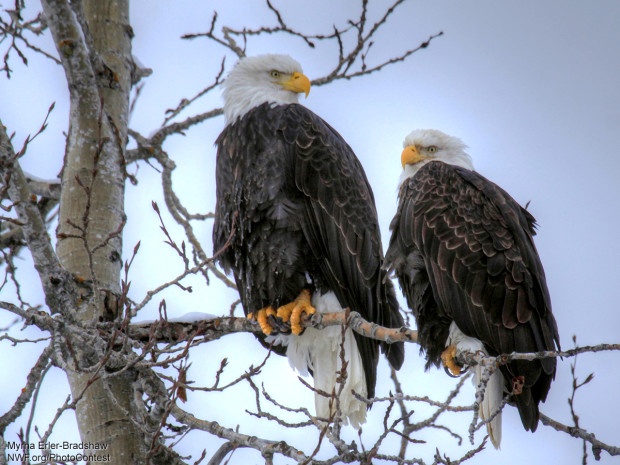We have much more to do and your continued support is needed now more than ever.
Bald Eagle Cam: Watch Decorah Eaglets Grow Up Live
We are gearing up for another year of bald eagle nest spying. The eagle cam, courtesy of the Raptor Resource Project, is a unique opportunity to witness bald eagle hatchlings grow up.
Status Updates for 2015
Feb. 18, 2015: First egg arrives
Feb. 21, 2015: Second egg laid
Feb. 25, 2105: Third egg appears
Mar. 28, 2015: First hatchling (D21) arrives
Mar. 29, 2015: Second eaglet (D22) hatches
Apr. 2, 2015: Third eaglet (D23) arrives
Status Updates from 2014
Feb. 23, 2014: First egg laid
Feb. 26, 2014: Second egg appears
Mar. 2, 2014: Third egg arrives
Apr. 2, 2014: First eaglet (D18) hatches
Apr. 3, 2014: Second hatchling (D19) arrives
Apr. 7, 2014: Third eaglet (D20) egg-scapes
Jun. 18, 2014: D18 & D19 fledge
Learn While You Watch
Not much happening in the nest? Take some time to read more about bald eagles, especially their nesting habits.
1. Bald eagles are solitary, but monogamous animals.
Although they spend winters and migrations alone, bald eagles maintain the same breeding pair year after year. If one dies, the survivor will find a new mate. The Decorah eagle pair has been together since the winter of 2007-08.

2. Bald eagles hold the Guinness World Record for building the largest bird’s nest.
The record nest measured over 9 feet wide and 20 feet deep, and was estimated to weigh more than 4,000 pounds. The Decorah nest is 5-6 feet across, about the same depth and weighs about 1½ tons. 3. The nest must be large and sturdy enough to hold the eaglets as they grow, and to handle the commotion as they learn to fly.

3. There are typically 1-3 eggs in a clutch.
The average clutch size is two, while four is considered rare. Bald eagles lay their eggs on a staggered schedule. As a result, the chicks hatch at different times, sometimes with a few days in between.
The eggs are incubated for about 35 days, a duty shared by both male and female eagles. During incubation, one of the parents is almost always on the nest. They do this to protect the eggs from predators and other threats.
4. Bald eagles clench their toes to avoid stabbing their eggs or eaglets with their sharp talons.
Bald eagles are very careful while moving around their nest, especially around their eggs and eaglets. Their talons are incredibly sharp, and could harm their young by accident. To prevent this, the eagles often clench their toes to hide their talons.
5. Eaglets practice flapping their wings for weeks before trying their first flight.
Bald eagles try their first flight 10-13 after hatching. The eaglets acquire flight feathers (known as fledging), and stay around the nest for an additional few months.
6. Bald eagles take their prey dead (carrion) or alive.
They feed primarily on fish, which is why their nests are typically near water. Bald eagles catch fish right off the water’s surface. Their food may include fish, birds, invertebrates, amphibians and more. Dead (carrion) or live prey are both acceptable to bald eagles. Occasionally they’ll wait for another eagle to catch a fish, and then try to steal it. Eagles feed their young by tearing food into small pieces, which eaglets take from their mother’s beak. After about five weeks, the eaglet is able to shred food on its own.
7. Approximately 50-70% of eaglets survive the first year of life.
Sometimes the last eaglet to hatch in a clutch is unable to compete with its siblings for food and doesn’t make it.
Bald Eagle Resources
- NWF Naturalist Answers Your Eagle Questions
- Learn more about bald eagles and the threats they face.
- Read an interview with the “father” of the Decorah Eagle Nest Cam.
- Frequently Asked Questions About the Eagle Cam
- Raptor Resource Project’s Blog
How to Help Bald Eagles
![]() You can help efforts to protect the bald eagle and its habitat by symbolically adopting an eagle.
You can help efforts to protect the bald eagle and its habitat by symbolically adopting an eagle.
Adoption packages include a certificate, poster, bald eagle plush and more.
History of the Decorah Eagles
We here at the National Wildlife Federation have been following the Decorah Eagles and their clutches of eaglets since 2011. That year, and in 2012, we featured live footage of the Decorah Eagles in their Iowa nest. The pair of eagles typically lay eggs in February, and the first eaglets usually hatch in late-March or early-April. In 2013, the eagles constructed an alternate nest, and there was no opportunity for the Raptor Resource Project to install live cams. However, the Center did install cams in this second, alternate nest (known as N2) last October.





















